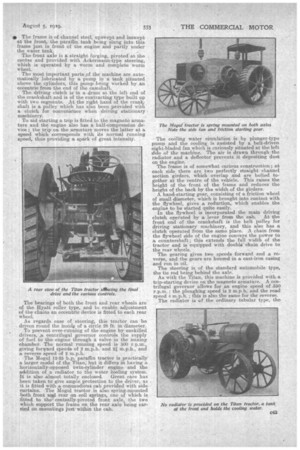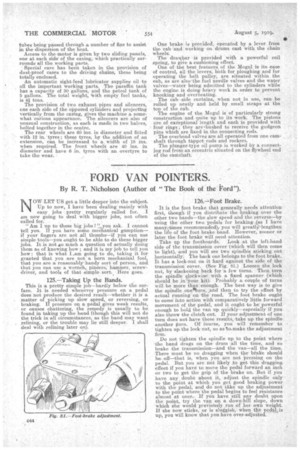TRACTORS FOR THE LINCOLN TRIALS.
Page 16

Page 17

Page 18

If you've noticed an error in this article please click here to report it so we can fix it.
Main Features of the Whiting-Bull, Titan and Mogul Models.
IN THE THREE-WHEELED clamof agricultural tractors one of the most interesting, and one which presents many novel features in its design, is the Whiting-null one-man outfit. With this tractor the front wheel, which is fitted into bicycle type forks,
and the right-hand rear wheel run in -the same furrow. The tractor has a rather curious appearance, as all three wheels are dissimillar. .
' It is provided Witha two-'cylinder horizontally-opposed engine of 51 ins bore and 7 ins. stroke, the normal running speed of which is 750 rdi-ex.ii. ' • No change-speed gears are fitted, the engine driving through spur g,earing and a roller pinion which
meshes with an internally-toothed ring on the largo driving wheel. The lama wheel is also driven by a roller pinion meshing with an internally-toothed ring bolted to it, but in this case the power is conveyed
to the pinion by et. chain from the countershaft. . The roller drive is of interest, and appears to perform its duties in cpiite a satisfactory manner. It has the advantage ef being oheap to replace.
No differential gear is included in the design.
In order to keep the tractor level when the main driving wheel is in the furrow, a hand-operated screw gear allows for raising and lowering the land wheel when required, 'without affecting its drive. The steering; gear is of the worm and sector type and operates through a long rod to the front wheel pivot. A speciargear-shift device on an extension of the crankshaft provides a reverse gear.
All the wheels are provided with Hyatt roller hearings. . The cooling water circulation is by centrifugal pump, which is driven from a pulley on the fan shaft,
the Pan being driven by a long belt from a pulley on the camshaft. This belt can be tensioned by means of a jockey pulley. The main clutch is incorporated with the fywheel and is of the band type lined with Eared° or some similar material.
The ma,chiThe has an ordinary petrel carburetter
and also a, paraffin vaporizer. The air is filtered through a patent dust trap, in which it impinges on baffles, the dust falling into a removable glass vessel at the bottom of the trap. This device appears to work in a satisfactory manner and is often found to berfull of dust at the end of a day's work.
c38 A belt-drive pulley is situated at the left-hand of the crankshaft close to the land wheel.
Pressure-fed lubrication by plunger pump operated from the camshaft is provided for the engine, and an overflow from the oil-distributing box runs to the centrifugal type governor, which is directly connected to the butterfly throttle valve.
The paraffin and petrol tanks are made of steel electrically welded, provision being made for 1E4 galloris of paraffin and 3-1gallons of petrol.
The ignition is. by high-tension magneto, fitted with a special impulse starter, which trips the armature over when starting and thus ensures a spark at low engine speeds.
in view of the forthcoming trials, it will be remembered that the Whiting-Bull did exceedingly well in the French tractor trials of 1917, with the result that the French Government ordered a large number of these tractors. It is claimed that an average day's work for this tractor is the ploughirig of an eight-acre field at a cost of 5s. 6d.' per acre .for paraffin, labour and oil, but exclusive of dppreciation.
The most interesting features incorporated in the 11-20 h.p. Titan paraffin tractor are the engine, which is a horizontal, two:cylinder,' side-by-side type, and the fact that no radiator is fitted, the cooling water being kept in a tank situated on the frame at thefront end. From this tank the water is circulated through a pipe from the bottom along the whole length of the cylinders and returns by way of a pipe
leading into the top of the tank. •
The twin-cylinder engine is of massive construction. The piatons are of unusual length and the piston pins are centrally situated ; each piston has four rings. The crankshaft is a one-piece forging provided with balance weights. Owing to the construction of the motor there is a power stroke for each revolution of the engine.
From the engine the drive is taken trough a countershaft and thence through a spur-gear-driven differential to. the two chain-driving 'sprockets, both rear wheels being 'driven by roller chains.
Thef.e speeds earing -gives two seds forward and a reverse, and the differential is of the bevel pinion type. The gear shafts are supported in long, white meta/ lined bearings.
Large diameter brake drems are cast integral with. the chain wheels./ The braking is done by external ' contracting bands operated by a pedal, vithich has a. ratchet clip to hold the brake on when required.
• The frame is of channel steel, upswept, and ins,wept at the front, the paraffin tank being slung into this frame just in front of the engine and partly under the water tank.
The front axle is a straight forging, pivoted at the centve and provided with Ackermann-type steering, which is operated by a worm and complete worm wheel.
The most important parts of the machine are automatically lubricated by a pump in a, tank ,situated above the cylinders, this pump being worked by an. eccentric from the end of the camshaft.
The .driVing clutch is in a drum at the left end of the crankshaft and is of the contracting type built up with two segments. At the right hand of the crankshaft is a pulley which has also been provided with a clutch for convenience when driving stationary machinery. To aid starting a trip is fitted to the magneto arma ture and the engine also has a half-compression device ; the trip on the armature moves the latter at a speed which corresponds with Its normal :running speed, thus providing a. spark of great intensity.
The bearings of both the front and rear wheels are of the Hyatt roller type, and to enable adjustment of the chains an eccentric device is fitted to each rear wheel.
As regards ease of steering, this tractor can be driven round the inside of a circle 28 ft. in diameter.
To prevent over-riinning of the engine by unskilled drivers ,a, centrifugal governor controls the supply of fuel to the engine through a valve in the mixing chamber. The normal running speed is 500 r.p.m., giving forward speeds of 2 m.p.h. and 21 m.p.h., and a reverse .speed of 2 m.p.h.
The Mogul 12-25 h.p. paraffin tractor is practically i a larger model of the Titan, but it differs n having a, horizontally-opposed twin-cylinder engine and the addition of a radiator to the water cooling system. It is also almost totally enclosed. Great care has been taken to give ample protection to the driver, as it is fitted with a commodious cab provided with side. curtains. The Mogul tractor is also spring-mounted both front and rear on coil springs, one of which is fitted to the centrally-pivoted front axle, the two which support the frame on the rear axle being carried on mountings just within the cab. The cooling water circulation is by plunger-type pump and the cooling is assisted by a belt-driven eight-bladed fan which is curiously situated at the left aide of the machine. The air is drawn through the radiator and a deflector prevents it depositing dust on the engine. The frame is of somewhat curious construction; at each side there are two perfectly straight channel section girders, Which overlap and are bolted together at the centre of the vehicle. This raises the height of the front of the frame and reduces the height of the back by the width of the girders. A hand-starting gear, consisting of a friction wheel of small diameter, which is brought into contact with the flywheel, gives a reduction, which enables the engine to be started quite easily. In the flywheel is incorporated the main driving clutch operated by a lever from the cab. At the front end of the crankshaft is the belt pulley for driving stationary machinery, and this also has a, clutch operated from the same place. A chain from the flywheel side of the engine conveys the power to a countershaft ; this extends the full width of the tractor and is equipped with double chain drive to the rear wheels.
The gearing gives two speeds forward and a reverse, and the gears are housed in a cast-iron casing and run in oil.
The steering is of the standard automobile type, the tie rod being behind the axle. As with the Titan, this machine is provided with a trip-starting device on the magneto armature. A centrifugal governor allows for an engine speed of .550 r.p.m. the ploughing speed is 2 m.p.h, and the road speed 4 m.p.h. ; this is also the same for the reverse. The radiator is of the ordinary tubular type, the tubes being passed through a number of fins to assist in the dispersion of the heat.
Access to the motor is given by two sliding panels, one at each side of the casing, which practically surrounds all the working parts. Special care has been taken in the provision of dust-proof cases to the driving chains, these being totally enclosed. An automatic sight-feed lubricator supplies oil to all the important working parts. The paraffin tank has a capacity of 30 gallons, and the petrol tank of 5 gallons. The total weight, 'With empty fuel tanks,• is 4i tons.
The provision of two exhaust pipes and silencers, one each side of the opposed cylinders and projecting vertically. from the casing, gives the machine a somewhat curious appearance. The silencers are also of unusual construction, as each is made in two halves, bolted together in the centre.
The rear wheels are 60 ins, in diameter and fitted with 12 in. tyres ; these tyres, by the addition of an extension, can be increased to a width of 18 ins. when required. The front wheel's are 40 ins, in diameter and have 6 in. tyres with an overtyre to take the wear. One brake is provided, operated by a lever from the Cab 'and working on drums cast with the chain wheels.
The drawbar is provided with a .powerful coil spring, to give a cushioning effect. One of -the best features of the Mogul is its ease of control, all the levers; both for ploughing and for operating the belt pulley, are situated within the cab, as are also'tbe fuel needle valves and the water valves—Water being admitted to the cylinders while the engine is doing heavy work in order to prevent knocking and overheating. The cab side curtains, when not in. use, can be rolled up neatly and held by small straps at the top of the cab. The engine of the Mogul is of particularly strong construction and quite up to its work. The pistons are of exceptional length and each is provided with four rings they are bushed to receive the gudgeon pins which' are fixed in the connecting rods. The overhead valves are all operated from one camshaft through tappet rods and rockers. The plunger-type oil pump is worked by a connecting rod from an eccentric situated on the flywheel end of the camshaft. •






















